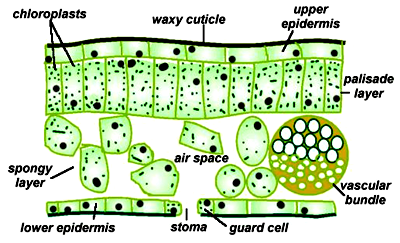When the leaf is cut in cross-section and seen under a microscope, the below structures are seen:
 |
| Figure: Internal structure of a Leaf |
Cuticle:
Cuticle is a transparent waxy layer covered on the upper surface of the leaf
Cuticle is made up of wax which is secreted by the epidermal cells
Functions of the Cuticle |
Cuticle allows light to pass into the leaf
Cuticle reduces water loss (acts as a waterproofing of the leaf)
Cuticle protects the leaf from drying out
|
Epidermis:
Epidermis is a single layer of cells on the upper and lower surface of the leaf.
The epidermal cells of the leaf don’t contain chloroplast.
Leaf epidermis keeps the leaf’s shape.
Epidermis of the leaf is divided into upper epidermis and lower epidermis
Upper epidermis:
Upper epidermis is found on the upper surface of the leaf and can be seen when the leaf is cut in cross-section and observed under microscope.
Cells of the upper epidermis are transparent
No stomata are present
Lower epidermis:
Lower epidermis is found on the lower surface of the leaf and can be seen when the leaf is cut in cross-section and observed under microscope.
Stomata are present
Upper epidermis:
Upper epidermis is found on the upper surface of the leaf and can be seen when the leaf is cut in cross-section and observed under microscope.
Cells of the upper epidermis are transparent
No stomata are present
Lower epidermis:
Lower epidermis is found on the lower surface of the leaf and can be seen when the leaf is cut in cross-section and observed under microscope.
Stomata are present
Functions of the Upper Epidermis of the Leaf |
|
Allows light to pass into the leaf
Acts as a barrier to micro-organisms
Secretes wax
|
|
Functions of the Lower Epidermis of
the Leaf
|
|
Acts as a protective layer
Site of gaseous exchange into and out of the leaf
|
Mesophyll tissue:
Mesophyll is the tissue between upper and lower epidermis of the leaf
Mesophyll tissue consists of:
- Palisade cells (palisade mesophyll cells) and
- Spongy cells (spongy mesophyll cells)
Palisade Mesophyll:
Palisade cells are elongated cells and box-like shape
Palisade cells are found below the upper epidermis
Palisade cells are closely packed together to absorb maximum light.
Palisade cells contain maximum amount of the leaf’s chloroplasts
Palisade cells are the main region for photosynthesis in the leaf
Palisade cells receive carbon dioxide by the diffusion from air spaces in the spongy mesophyll.
Chloroplasts in the palisade cells are able to move within the cytoplasm.
During dim light, chloroplasts in the palisade cells move to the upper parts of the cell allowing them maximum absorption of light.
In bright light, chloroplasts in the palisade cells move to the lower parts of the cell for protection from the bleaching effects of intense light.
Spongy Mesophyll:
Spongy cells are irregularly shaped cells with large air spaces between them
The air spaces between spongy cells are known as intercellular air spaces.
Air spaces between spongy cells allow gaseous exchange in the leaf.
Spongy cells allow of gaseous exchange in the leaf.
Spongy cells contain viewer chloroplasts
Functions of the Palisade Cells
|
|
Photosynthetic site of the leaf
|
|
Functions of the Spongy Cells
|
|
Site of gaseous exchange in the leaf
|
Vascular bundles:
This is the leaf vein, made up of both xylem and phloem.
Xylem vessels bring water and minerals to the leaf cells.
Phloem vessels transport sugars and amino acids away from the leaf cells through the a process called translocation.
They also provide support for the leaf
Stomata:
Stomata are tiny pores found at the lower epidermis or underside of the leaf.
Stomata are always open during day time and close in the night time.
Each stoma is surrounded by a pair of guard cells.
Guard cells are pair of cells that surround each stoma.
Guard cells control whether the stoma is open or closed.
This is the leaf vein, made up of both xylem and phloem.
Xylem vessels bring water and minerals to the leaf cells.
Phloem vessels transport sugars and amino acids away from the leaf cells through the a process called translocation.
They also provide support for the leaf
Stomata:
Stomata are tiny pores found at the lower epidermis or underside of the leaf.
Stomata are always open during day time and close in the night time.
Each stoma is surrounded by a pair of guard cells.
Guard cells are pair of cells that surround each stoma.
Guard cells control whether the stoma is open or closed.
Functions of the Stomata |
|
Allow exchange of CO2 and O2
Transpiration takes place
|
|
Functions of the Guard Cells
|
|
Control whether the whether the stomata are open or close
Help to regulate the rate of transpiration by opening and closing the
stomata (control water loss)
|
Stomatal opening during day light:
Potassium ions (K+) move into the guard cells
Solute concentration in the guard cells increase
Water moves into the vacuoles of the guard cells (Endosmosis of water)
The guard cells expand and become turgid
The stomata open
Stomatal closing during night/dark time:
Potassium ions (K+) move out of the guard cells
Solute concentration in the guard cells decrease
Water moves out of the vacuoles of the guard cells (Exosmosis of water)
The guard cells shrink in size and become flaccid
The stomata close
 |
| Figure: Mechanisms of stomatal opening and closing |
 |
| Stoma open during day time and close in night time |
 |
| Figure: Internal structure of a Leaf |
No comments:
Post a Comment